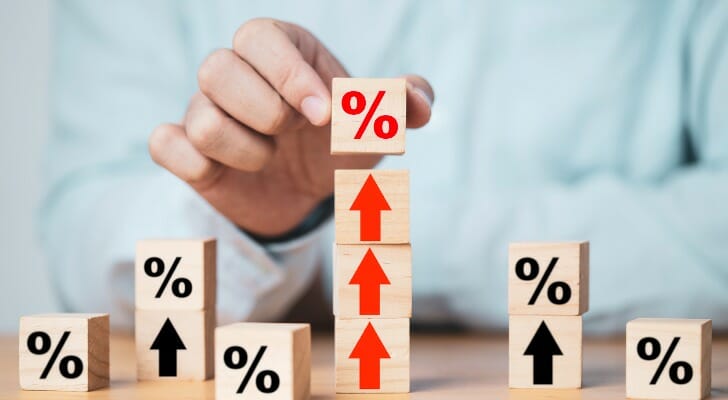Interest rates and bond prices generally move in opposite directions. Thus, when interest rates go up, the price of fixed-rate bonds usually falls. Similarly, a fall in interest rates causes the price of fixed-rate bonds to increase. This dynamic is generally understood among investors, but what is not always understood is why it works this way. To understand the relationship, we must look more closely at how changing interest rates affect the value of bonds. If you’re interested in investing in bonds or need to better understand how rising interest rates might impact your financial plan, you may benefit from speaking with a financial advisor.
Why Do Interest Rates Rise?
Interest rates usually rise in response to rates of inflation that are seen as unacceptably high. When we say “interest rates” here, what we are referring to is the federal funds rate set by the Federal Open Market Committee (FOMC).
The federal funds rate is the cost to borrow money. Hence, when this rate increases, money becomes more expensive to borrow. This leaves people with less money to spend, which can help cool the surging demand that previously drove up prices.
Of course, the Fed can also do the opposite. It can lower the federal funds rate if the economy is stagnating, making money cheaper to borrow and causing demand to increase.
How Interest Rates Affect Bonds
Although interest rates usually rise in response to rising inflation, this can have an unintended consequence on bonds. To understand this, we must establish that bond yields are based on a bond’s annual interest rate, also known as the coupon or coupon payment, and price. The bond’s coupon payment is the amount the bond pays in a year. That amount divided by the bond’s market price determines the yield. Thus, bond yield is calculated as:
Bond yield = Annual coupon payment / Bond price
Hence, if bond prices change, so do bond rates, and thus, yields. For example, suppose you have a $500 bond with an annual coupon payment of $50. This gives the bond a 10% yield ($50/$500). But if the bond price falls to $400, the yield increases to 12.5% ($50/$400). If the bond price increases to $550, the yield drops to about 9% ($50/$550).
Rising and Falling Interest Rates

The way we’ve talked about bonds so far, you might think that bond prices are the moving target. But interest rates have been the “perpetrator” all along. To illustrate this point, let’s use a slightly different example. Suppose you hold a bond that currently pays a 3% yield. However, due to the current economic climate, the Fed decides to raise the federal funds rate to 5% (it did this in 2006).
Because your bond only pays a 3% yield, it won’t be very attractive in this environment, causing its price to drop. However, a drop in the bond price increases the yield (refer to our formula above). The price of our bond continues to fall until its yield is in line with the 5% rate set by the Fed.
The opposite effect can also occur. If the federal funds rate decreases, say, to 2%, the price of our bond would increase until its yield is in line with the rate set by the Fed.
The Effect of Rising Inflation
Bonds can be less attractive when inflation is high. In this type of environment, investors value regular interest payments less and bond prices drop while yields increase. This combination of lower bond prices and higher yields could make bonds attractive to some investors; however, if inflation is brought under control, bond prices will tend to increase and yields will drop as a result. Investors who are drawn in by high yields could find themselves with lower yields later.
Bonds can act as an inflation hedge; some investors buy bonds such as Series I Savings Bonds or Treasury Inflation-Protected Securities (TIPS) for this very purpose. Both assets can be effective in controlling for inflation in the long run. Bonds can also reduce the volatility of your portfolio’s performance. However, keep in mind that bonds tend to underperform stocks in the long run.
Bottom Line

Interest rates usually rise in response to rising inflation rates. The Fed increases the federal funds rate, which can help bring inflation under control. However, rising interest rates also tend to reduce the price of fixed-rate bonds. While this increases the yield, it also means that if you later sell your bonds in a high-interest-rate environment, you would be forced to sell them at a lower price.
Bond prices are sometimes expressed through a seesaw metaphor because rising interest rates come with falling bond prices and vice versa. However, this metaphor also gives a nod to the volatile nature of bond prices and yields. Indeed, they can be a bit up-and-down sometimes. Nevertheless, bonds can help stabilize a portfolio because they are more predictable, leading to more stable prices overall.
Tips for Investing
- Deciding how to invest your money can be a tough decision. Working with a financial advisor can be useful as they will help you match your goals to the best investment strategy. Finding a qualified financial advisor doesn’t have to be hard. SmartAsset’s free tool matches you with up to three financial advisors who serve your area, and you can interview your advisor matches at no cost to decide which one is right for you. If you’re ready to find an advisor who can help you achieve your financial goals, get started now.
- Deciding how to invest what portion of your portfolio in stocks and what portion in bonds can be challenging. You want the best possible performance, but you don’t want to take on excessive risk. SmartAsset’s asset allocation calculator can help you understand what allocation makes the most sense relative to your risk tolerance.
Photo credit: ©iStock.com/LanaStock, ©iStock.com/Dilok Klaisataporn, ©iStock.com/FG Trade
